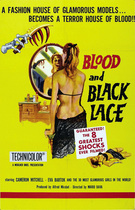Our editor-in-chief Nate Yapp is proud to have contributed to the new book Hidden Horror: A Celebration of 101 Underrated and Overlooked Fright Flicks, edited by Aaron Christensen. Another contributors include Anthony Timpone, B.J. Colangelo, Dave Alexander, Classic-Horror.com's own Robert C. Ring and John W. Bowen. Pick up a copy today from Amazon.com!
Non-Horrors of the 21st Century
We're almost halfway this decade. And, truth be told, it's a pretty meager harvest considering the size of the industry and its output. Most horror movies are borderline action flicks: overblown, loud, fast cut and, most of all, pre-formatted. Cryptic interludes with whooshy screen change-overs, slick actors and actresses with equally slick dialogue lines, grey overtones added in cinematography postproduction, and a narrative swiftly converging into a singular plot resolution: behold chapter one from 21st Century Horror Movie Productions, A Concise Manual.
Chapter two is about marketing. More specifically, it's about MPAA ratings and how to make them commercially work. Ratings have become a producer's quintessential marketing tool. Movies are targeted to a specific rating, hence to a specific audience bracket. That audience is, of course, the market for the movie. The lower the rating, the bigger the movie's marketing potential. But horror movies, by nature, dish out extremities. They aim to induce fear with the viewer. Given the mechanics of film ratings, a horror movie already has a grade or two down just by calling itself so. A producer's predicament: how to reach the widest conceivable audience with a movie that already has a few odds against it ratings-wise when it's not even storyboarded yet. Besides, who's going to watch a horror movie that's admissible for all audiences?
To solve this, the rating borders are tested. For a PG-13 rating, delete the profanities until there are two or three left, and forget about nudity and drug use. For an R-rating, you can leave the blood in but cut down on the gore, and be careful with drug use and nudity. Failing to do so will result in NC-17, which will result in more profanity coming from the producer's office than a movie with a firm R-rating will ever let you hear. Producers want return on investment and, in this age of moral and ethical terrorism, this is how to optimize the odds.
But of course, horror is much more than foul language and pig entrails. So how to make a horror movie, shock the audience, and still remain politically correct within the scope of the desired rating? Throw in lots of CGI for starters. Pace the movie up into roller coaster gear so the viewer will have a subconscious déjà vu with that CG-game he played or video clip he saw on MTV the other day. Role model your protagonist and antagonist after comic book heroes, or stylize them that way. Make a teen action movie on a horror premise, and you're home free. The MTV crowd loves it and the movie will safely fall within the scopes of the desired rating.
Is there anything left, or at least to hope for, for the serious horror fan?
I believe there is. People started making horror movies as soon as they could shoot a movie. The genre is not going to eventually disappear. A French director named Georges Meilies arguably made the first horror movie... in 1896 (The Devil's Castle). Horror is as old as cinema, and will remain with it. So, of course, time is a cure. The over-decency plaguing our beloved genre will eventually pass again when the currently fashionable formula grow stale. Every fashion takes about a decade to die out and so will this one. It's encouraging to realize that we should be about halfway there. But there's more.
Brave, mostly young and dedicated producers are looking for innovative ways to put a movie together. Of course, East Asia is now a fertile breeding ground for new and engaging horror cinema. Japan has a massive influence on the innovative 'return to silence' in modern horror movies by reinventing the law of visual dynamics: a shock is enhanced in a silent context. This goes back to the psychological basics of primal fears: fear of the unknown. In stark contrast with the mostly sense-bombarding and numbing movies of Western origin, these movies leave a lot to the imagination. They force the viewer to resolve his own anxieties as he gets drawn into the movie by compelling narratives, immaculate cinematography and powerful acting performances. In the wake of Japan's successes, Asian movie crops are further grown by moviemakers from Thailand and South Korea - and fruitfully so.
The Asian quality horror outburst didn't go unnoticed in the West. Big production companies purchased remake rights; these remakes were made, released, and have proven to be commercially viable in Western markets. The horror purist will probably frown at any remake, including these. But there's also a good side to it. American, Canadian and British moviemakers are trying to further develop the genre by digging up new ways to blend one with the other. I am positive that new things will come out of this. Let them remake the Asian gems. Let them learn how things were done back then, and are now done over there, and give them the chance to develop something out if it. Repetition is always the first teacher.
Also on domestic territories, things are brewing. 70s horror is reinvented, revived, reinterpreted and remade. With various levels of success in terms of commercial success, artistry or entertainment, but still, the efforts are always noteworthy, trying to blend the old with the new, and occasionally even reaching beyond the new to incorporate some originality. I know they're still baby steps, but still, encouraging enough for me not to be pessimistic about America's horror future.








Could you please explain me
Could you please explain me the meaning of 'CGI'
Computer Generated
Computer Generated Imagery.
Nate Yapp
Editor-in-Creep
Classic-Horror.com
"He went for a little walk! You should have seen his face!"